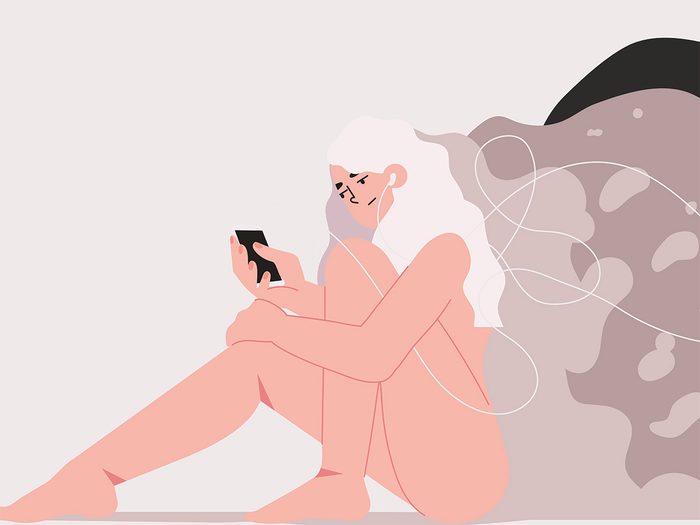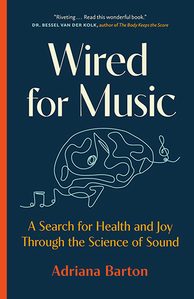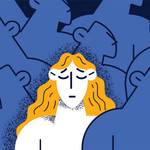Why Can Sad Music Help Us Feel Better?

Health journalist Adriana Barton explores music’s effects on our brain and body in her new book, Wired for Music. Here, she looks at how it can aid with depression, anxiety and stress.
In 1985, when Barton was 15, two of her music-academy classmates, Aruna and Rupa Anantaraman, died in the Air India bombing. Barton spent the following year listening to her idol, cellist Jacqueline du Pré, playing Sir Edward Elgar’s haunting Cello Concerto in E Minor on repeat.
Looking back, I’m not sure why I never connected my Elgar ritual to the loss of Aruna and Rupa. All I knew was it made me feel better. Now I understand why: People struggling with depression often gravitate to melancholy music. And it turns out we have healthy reasons for choosing sad songs when we’re down.
Psychologists used to consider this behavior maladaptive, a form of wallowing. But Jonathan Rottenberg, director of the mood and emotion laboratory at the University of South Florida, didn’t believe people would choose music that compounded their depression. “Their mood state is extremely unpleasant,” he pointed out. “They go [into] therapy and say, ‘I want to snap out of this.’”
He and a graduate student, Sunkyung Yoon, tested this hunch in a 2020 study using music rated by Western audiences as neutral, happy, or sad. Tracks ranged from Jacques Offenbach’s peppy “Infernal Galop” to Samuel Barber’s doleful “Adagio for Strings.” Overall, people with clinical depression showed a strong preference for somber music, saying it made them feel calmed, soothed, and “even uplifted.”
This won’t surprise anyone who has found comfort in Mozart’s Requiem or Lady Gaga’s “I’ll Never Love Again.” Sad songs never pressure us to snap out of it. In a survey of adult listeners, one described how downer tunes helped her “cry a little and then feel relieved, and move on.” Another said she felt “befriended” by the music.
Like an empathic friend, sad songs meet us where we’re at. And when we’re in a funk, chirpy lyrics can feel like annoying platitudes. How many people in a blue mood walk around singing “Don’t Worry, Be Happy”? To paraphrase an Internet meme about calming down, never in the history of “Cheer up!” has anyone cheered up by being told to cheer up.
Certain songs always make me misty-eyed, like the late singer Eva Cassidy’s soaring cover of Sting’s “Fields of Gold.” Another is Tracy Chapman’s “The Promise.” When she sings the words “I’ll find my way back to you,” she gets me every time.
Poignant music invites us to savor emotions that can be painful but also intensely beautiful. In fact, sad songs may stimulate our body’s pleasure responses, including “goose-bumps” and “chills,” as much as or more than happy music. And as noted in Japanese research, when songs make us weep or put a lump in our throat, music can trigger a cathartic release.
Even in moments of extreme suffering, music offers solace. A journalist friend, Jennifer Van Evra, told me about visiting her neighbor Roy in palliative care as he lay dying of bone cancer. Doses of morphine made him drift out of consciousness, but at times he’d revive in agonizing pain from the disease. On one visit, “he was inconsolable.” Knowing he loved music and had once been a churchgoer, Jennifer pulled out her phone and asked if he knew any hymns, “but he was too out of it to name any.” She played “Amazing Grace” followed by “Silent Night,” and to her amazement, he began to sing along. “You could just see this calm wash over him.”
Music reaches us at a level beyond conscious thought. More than any other artform, it is both “completely abstract and profoundly emotional,” wrote the late neurologist Oliver Sacks. “Music can pierce the heart directly; it needs no mediation.”
Early psychiatrists had an intuitive grasp of music’s mood-enhancing effects. In the mid-nineteenth century, specialists in Baden, Germany, believed individuals with mental illness healed best in a pastoral setting with plenty of music— especially Mendelssohn. The local asylum, Illenau, urged patients to sing in the choir, join the in-house band, and try writing their own compositions. Music and singing, Illenau officials wrote, were “indispensable” to patients as “therapeutic instruments.” Months after her stay, one former patient sent a letter requesting copies of her three favorite Illenau songs, saying they reminded her of her restored health and of “feeling all singing-like.”
Through the ages, though, no one knew what was happening in the brain when music calmed an agitated patient or roused a listless soldier from a catatonic state. At last, near the turn of the twenty-first century, a critical mass of scientists began to shed light on the mind-boggling chemicals and electrical patterns activated by music.
One of these scientists grew up in Argentina listening to pop music and tango like everyone else. But at age thirteen, Robert Zatorre got his hands on a vinyl recording of music by the Hungarian composer Béla Bartók. He started playing it out of curiosity—and was blown away. “I had chills down my spine. I had goose bumps,” he said. “I just felt this unbelievable sensation that I really couldn’t explain.” That day, he decided he would learn to play music and study it scientifically, too.
Zatorre trained as an organist while earning degrees in experimental psychology. When he joined the Montreal Neurological Institute (the Neuro) in 1981, it was one of a handful of centers in the world doing brain imaging in humans. Zatorre, still at the Neuro, explained to me how music gives us joy, and even euphoria, through some of the same pathways stimulated by chocolate, cocaine, and sex.
Zatorre and Valerie Salimpoor, a McGill graduate student, became the first to prove that music triggers dopamine in the brain. Dopamine is the main driver behind addictive behaviors such as gambling, compulsive shopping, and recreational drug use. Dubbed the “Kim Kardashian of molecules” by a British psychologist, this racy chemical prods us to get more of what we want and crave.
When music builds to a peak moment during, say, a drawn- out drumroll, we get a surge of dopamine. Then, if the climax exceeds our expectations—with, perhaps, a spectacular crash of cymbals—dopamine spikes again.
Dopamine isn’t the only chemical involved in musical pleasure, though. The brain makes its own versions of heroin, morphine, and cocaine. Known as “endogenous opioids” (“endogenous” meaning “of internal origin”), these chemicals give us everything from a “natural high” to a mild tranquilizing effect. Endorphins, for example, are short for endogenous morphines.
Whether extracted from poppies or made in the brain, opioid molecules behave in similar ways: They attach to tiny receptors throughout the brain and other organs, including the stomach, nervous system, and lungs. Plugged into our opioid receptors, these molecules can trigger a whole-body response to music, like the wave of euphoria fans have at rock concerts.
Along with his colleagues in Spain and France, Zatorre theorizes that music gives us two kinds of delight: intellectual enjoyment and physical pleasure—goosebumps, chills, prickles down the spine. In one study, listeners given a dopamine-enhancing drug said they liked the music significantly more than when they took a dopamine-blocking drug. Dopamine changed their reported enjoyment.
Next, in a prepublished study, Zatorre and colleagues repeated the experiment with an opioid-enhancing drug. This time, music listeners showed strong physical pleasure—goosebumps and chills—yet the drug had little effect on how much they said they enjoyed the music. An opioid-blocking drug didn’t change their reported enjoyment much either. Clearly, their bodies responded to music differently than their minds.
While the roles of dopamine and natural opioids remain “very much under debate,” said Zatorre, he believes dopamine may be responsible for our mental or aesthetic enjoyment of music, while opioids enhance physical pleasure in music.
This theory makes sense considering how the brain’s pleasure-and-reward pathways evolved. Early on, physical pleasures, from sweet foods to sex, helped keep us alive. As the human brain developed, though, we learned to find pleasure in things that required higher-level thinking, such as basking in Brahms. Cocaine and sex give us a rush of pleasure, but we also get hits of bliss from what neuroscientists call “aesthetic” or “cognitive rewards.”
Pleasure is life-affirming. In contrast, a lack of pleasure in normally enjoyable things is a hallmark of clinical depression. But tinkering with the brain’s pleasure chemicals in a lab isn’t enough to prove that music can lift depression or soothe anxiety. For this, we need documented mood changes in real people. Fortunately, we do have studies like these. Loads of them.
Over coffee with a new friend, I asked what she’d want to learn about in a chapter I was writing on music and mood.
“Anxiety,” she said, “because I have it.”
Despite holding a driver’s license for nearly two decades, up until four years ago, Liliana Moreno seldom got behind the wheel. As a child in Colombia, she was riding in the back of the family car when her father rounded a sharp corner—and collided with a bus. No one was injured, but the accident made her so skittish that she avoided driving until her son outgrew the after-school programs they could reach by bus. Luckily, she found something to soothe her nerves: music. Whenever she puts the key into the ignition, she plays chill tunes from artists such as Rüfüs Du Sol, an Australian group, or Nora En Pure, a deep-house producer born in South Africa. “It helps,” she said. “It’s my therapy.”
When I mentioned that her remedy has a scientific basis, she beamed.
The evidence comes from surgical wards, where patients with acute anxiety end up with more pain, a higher risk of infection, and longer recovery times. Although sedatives calm most patients, they also carry the risk of breathing problems, blurred vision, dizziness, and agitation. Anesthesiologists searched for alternatives.
At a Barcelona hospital, one group of surgical patients received a standard dose of Valium. A second group listened to half an hour of classical or new-age music, both the day of the procedure and the night before. Just before the surgeries, researchers measured patients’ blood pressure, heart rate, cortisol, and anxiety levels. They found no difference between the two groups. As a treatment for preoperative anxiety, they concluded, music was “as effective as sedatives.”
A lone study, however, shouldn’t convince anyone to swap Valium for Norah Jones. That’s where Cochrane comes in. This global network of evidence-based research conducts stringent reviews of dozens of studies to weed out dodgy health information. In four separate reviews of music for preoperative anxiety—the most recent covering twenty-six studies—Cochrane confirmed that music offers a “viable alternative” to standard sedatives.
Music may not soothe every soul, as some may be less responsive to its calming effects. Those suffering from severe anxiety, from phobias to post-traumatic stress, should seek professional help. Still, if music can compete with tranquilizers in a nerve-wracking hospital environment, in my eyes, it’s potent enough to take the edge off garden-variety anxieties, such as preflight jitters.
Then there’s stress. We tend to lump anxiety and stress together because both cause sleepless nights, fuzzy thinking, headaches, and irritability. Anxiety encompasses everything from acute fears to persistent phobias. Stress, on the other hand, starts as a physiological response. When we’re under threat, cortisol raises blood sugar levels for quick energy, while adrenaline causes our heart rate to quicken, readying us for “fight, flight, or freeze.” If the threat persists, our bodies stay on high alert, keyed-up in a state of chronic stress.
Here, too, music can dial us down. A Dutch review of 104 clinical trials described music’s “moderate tranquilising” effects as “very significant” for preventing and treating symptoms of stress. It didn’t matter whether people worked with a music therapist, heard live music in a group, or listened to recorded music alone. Based on results in a total of 9,617 participants, music lowered heart rate, blood pressure, and cortisol levels, along with nervousness, restlessness, and feelings of worry.
After a rough day at the office, though, how to choose the ultimate chill tune?
Music at 60 to 80 beats per minute, the pace of a resting heartbeat—a rhythm we hear in the womb—appears to lower stress best. Just 20 to 30 minutes of slow-paced music, noted the Dutch review, has “a direct stress-reducing effect.”
On YouTube and Spotify, playlists arranged by beats per minute are easy to find: slow tracks range from Otis Redding’s version of “My Girl” to “Take Five” by the Dave Brubeck Quartet. That said, dopamine increases most when we enjoy the music. And a listener’s preferences—not the music genre—has the greatest impact on brain connectivity in our default mode network, involved in empathy and self-awareness.
What if we loathe the tunes? Hypothetically, if we find them irritating (like the new-age Muzak I can’t stand) even so-called “relaxing” music could ramp up stress.
One listener’s medicine is another’s poison.
—
As a child, I learned a piece that sprinted up and down the cello in runaway triplets, exhilarating to play. Maybe it was the odd mix of a jolly tune in a foreboding minor key, but I never tired of this “Tarantella.” Not until decades later did I learn that the composer, William Squire, took his inspiration from a mysterious illness that had plagued the Mediterranean for several hundred years. While tending rows of tomatoes and spicy peppers, peasants developed sudden breathing problems, melancholy, and a “sensation of dying.” They blamed their symptoms on the venom of the European tarantula spider. Frenetic dancing to tarantella music was the only cure.
At harvest time in southern Italy, this musical antidote was in such demand that fiddlers reportedly wandered the fields like mobile first-aid units, ready to strike up a rousing tarantella at first bite. In Spain’s La Mancha region, eighteenth-century physicians treated more than fifty cases of “spider sickness” with everything from bloodletting to viper’s grass. In the majority of patients, however, only tarantella music restored the will to live.
But this remedy makes no sense. Vigorous dancing should cause the toxin to spread through the bloodstream faster, worsening symptoms instead of relieving them. Adding to the puzzle, many victims showed no sign of spider bites. What to make of this dubious illness and its musical cure?
Modern scholars have described tarantism as a “mass psychogenic illness” triggered by mental distress and spread to large numbers through “social contagion.” Belief in the spider sickness gave depressed peasants a socially acceptable culprit for their miseries under feudalism. More importantly, it gave them an excuse to get out of the field ruts and join in a mood cure that literally put a spring in their step.
I’ll bet the peasant remedy actually worked. In a large 2017 review, German researchers noted “highly convincing” evidence that music improves symptoms of depression and quality of life.
The poet Emily Dickinson described depression as “a funeral” in the brain. Interfering with work, school, and social relationships, this mood disorder brings persistent feelings of sadness and low self-worth, along with sleep problems, lack of energy, and, often, thoughts of suicide. While up to two-thirds of clinically diagnosed people may improve with antidepressants and talk therapy, in a Cochrane review, music therapy offered an extra boost compared to standard treatments alone.
Of course, music therapy isn’t the same thing as moping around listening to sad cello concertos. Music therapists have extensive university-level training in using music to treat physical, cognitive, and emotional issues. To improve hand- eye coordination, for example, a music therapist might ask a patient to play notes on a xylophone. Depending on the condition, from brain injury to extreme grief, people working with a certified music therapist might show improvements beyond what other treatments can offer. With depression, though, it’s unclear whether music therapy relieves symptoms any better than music listening “prescribed” by a doctor or nurse (known as “music medicine”). This puzzled me, because more often than not, a health strategy that involves human connection wins out.
In a study of cancer patients with low mood, music therapy and solitary listening offered similar benefits. Many patients preferred working with a music therapist, saying they liked the feeling of camaraderie and support. But others felt anxious or even hostile when a therapist handed them an instrument or asked them to sing. Left alone with headphones, one patient said, “You can concentrate more on your music, and it’s like it relaxes you more.”
Music, as Oliver Sacks said, “needs no mediation.” Our pleasure-and-reward pathways are easily stimulated by rhythm and song. Moreover, some scholars suggest the brain’s endogenous opioid system may also be directly involved in regulating mood. While the details are still being worked out, music is proving to be a fast-acting antidepressant. A 2020 analysis reported a “significant reduction” in depression symptoms from twenty- to forty-minute sessions of either music therapy or music medicine. And shorter treatment periods—twelve sessions or fewer—showed the most benefit.
Just about any music can offer temporary relief. Studies have used everything from European classical to Indian ragas, Irish folk to reggae, and lullabies to rock. The genre doesn’t seem to matter, as long as people have a choice. The more we like the music, the better our chances of experiencing a mild, depression-lifting euphoria. Depending on our tastes, the most effective musical antidepressant might be anything from a showstopper from Hamilton to the golden oldies Grandma used to sing while making pie.

Adapted with permission of the publisher from the book Wired for Music: A Search for Health and Joy Through the Science of Sound written by Adriana Barton and published by Greystone Books in October 2022. Available wherever books are sold.
Next: Looking to Improve Your Workout Performance? Change Your Music




